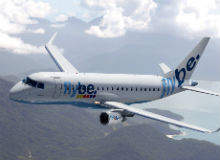

The UK’s regional airports – defined as those outside London – handled 87.7m passengers in 2013, an increase of 3.5% on the previous year and Department for Transport (DfT) forecasts predict this number will grow to 150 million by 2030, by which point all London airports will be full to capacity.
How well do you really know your competitors?
Access the most comprehensive Company Profiles on the market, powered by GlobalData. Save hours of research. Gain competitive edge.

Thank you!
Your download email will arrive shortly
Not ready to buy yet? Download a free sample
We are confident about the unique quality of our Company Profiles. However, we want you to make the most beneficial decision for your business, so we offer a free sample that you can download by submitting the below form
By GlobalDataWith London Mayor Boris Johnson’s vision of a new hub in the Thames Estuary grounded and debate over additional runway infrastructure at Heathrow and Gatwick ongoing, the Coalition Government has pledged to incentivise investment in regional airports in an effort to boost the UK’s freight and passenger capacity, create new routes, increase connectivity and trade, and support regional jobs.
Established in 2013, the Regional Air Connectivity Fund is available to airports with fewer than five million passengers a year. A total of £56m is available to cover three years of financial support for start-up aid, with £17.5m available to 2015/16 bids and £20m a year for each of the remaining years.
"Smaller airports are vital to local economies and ensuring they thrive is a key part of our long term economic plan," said Aviation Minister Robert Goodwill. "I want to encourage the industry to apply to expand their routes, to generate UK growth and jobs, as well as boosting our trade links with countries all over the world."
Minority report: CAPA questions UK regional funding policy
Bids for funding must be made by a consortium or ‘route promoter’ comprising an airport with less than five million passengers per annum, an airline that will operate the route and, where suitable, local authorities and trade bodies. The UK DfT will deal with the route promoter, but European Commission (EC) guidelines dictate that payments for start-up aid can only be made to the airline.
Coupled with the UK Chancellor’s 2014 budget decision to lower air passenger duty for long haul flights, this regional funding strategy makes sense, at least in the short term, as a way of easing capacity constraints for UK operators facing fierce competition from aggressive low-cost carriers.
However, a 2014 report by the Centre for Aviation (CAPA) points out several shortcomings in the regional funding model. The first relates to submission criteria and the term ‘regional’, which is often used to describe non-London airports. But, as the report points out, London Stansted is often referred to as a ‘regional airport’, while London City arguably has its own regional catchment area.
Second, the report draws the reader’s attention to five previous regional development funds (RDFs) that were established or considered in Scotland, Northern Ireland, Wales, the North West of England and the North East of England in the early 2000s. It concludes that low cost carriers (LCCs) were the major winners during their operation and that few start-up long-haul services actually went ahead.
The report also argues that the question of how regional services were to become self-supporting once the three-year support period expires – the regional development funding replaced by untried and tested Local Enterprise Partnerships (LEPs) – was never properly answered.
Finally, the CAPA research notes that the majority of smaller UK regional airports simply don’t have the runway capability for flights to long-haul destinations such as Brazil or Indonesia. Instead, they operate in the short-haul LCC zone, their passengers jetting away on holiday rather than jetting in to do business, exactly the sort of no-frills services that previous schemes wished to discourage.
Case study: Flybe thrives with help from the Regional Air Development Fund
Despite the CAPA’s scepticism, the Regional Air Development Fund is not without its success stories and has already benefitted several provincial hubs, including those that were overlooked by the decidedly London-centric Interim Report of the Airports Commission released in December 2014.
Previous beneficiaries of the funding include the Newquay to Gatwick airport route flown by UK independent Flybe. Newquay’s future looked in doubt as recently as 2013, when Flybe announced it was stopping its daily London Gatwick service. The government decided to step in to subsidise the route and also helped fund a £6m industrial park. Chief Secretary to the Treasury Danny Alexander describes the route as being "vital for Cornwall’s businesses tourist industry and residents.
"This fund has already supported valuable services like Newquay’s London route, which has a return of 2.5 for every pound invested, making it great value for taxpayers too," he said.
Like many smaller operators, Flybe has chosen to diversify its revenue streams and develop strategic partnerships with major global carriers. The operator based in Exeter, Devon, has close ties with Air France and codeshare agreements with BA, Etihad, Finnair and KLM, reports Flightglobal.
Flybe’s model is noteworthy for several reasons. Firstly, roughly 75% of its capacity is still devoted to independent regional transport. Second, by interlining with multiple carriers – and codesharing or contracting with five majors – the airline is far less vulnerable than many of its independent rivals.
Third, Flybe flies to and from major hubs, but not between them. Finally, it supplements its regional revenue with related ventures such aviation support, charters, pilot training, air ambulance service.
Proceed with caution: why UK regional hubs face an uncertain future
Flybe, one of the five confirmed airlines that have submitted a total of 19 initial applications for the 2015/16 Regional Air Connectivity Fund, is proposing new daily routes between Norwich and Paris Charles de Gaulle, and Norwich and Dublin, both with scheduled start dates of 1 April 2016.
Among the other bids is a daily Stobart Air service between Carlisle and Belfast, and daily weekday Bmi Regional route between Doncaster Sheffield and Frankfurt. A short-list of routes that have met the necessary EC criteria will be published in May, with successful bids being announced in July.
In addition to generating new routes, money from the revitalised Regional Air Connectivity Fund is also being earmarked to maintain existing public service obligation (PSO) services, the term given to passenger services that are not profitable in a free market, but are instead are socially desirable.
Despite interest in this funding round, many regional airports remain unprofitable and face closure. While there is a potential for more feeder flights from the small UK airports to genuine European hubs such as Amsterdam and Frankfurt in most cases those services already exist and are proven to be viable , with or without start-up funding assistance from the UK Government.
In 2007, a number of UK airports with fewer than one million passengers annually saw declines of 40% or more in the next five years, compared with an overall UK drop of 8.1%, reports the Financial Times, and many smaller hubs have been forced to close as LCCs continue to flood the market.
Manston in Kent and Bristol Filton were sold to property developers, while Plymouth City was closed in December 2011. In 2013, the Scottish government bought Glasgow Prestwick for £1, following the example of the Welsh Government, which took Cardiff into public hands that same year.
"You need half a million to a million passengers a year to service an airport," said David Bentley, an analyst at the Centre for Aviation in Manchester. "Since 9/11, regional airports have been left competing for low-cost carriers, who can drive down their fees. Over 40% of airports in Europe do not make a profit."




